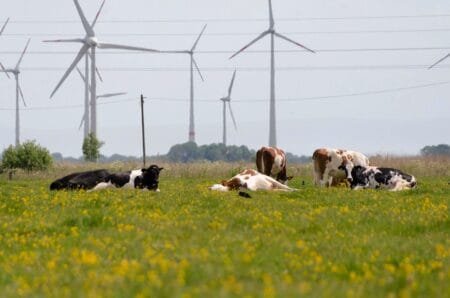To help repair the economic and social damage brought by the coronavirus pandemic, kick-start European recovery, and protect and create jobs, the European Commission presented on 27 May 2020 a major recovery plan for Europe based on harnessing the full potential of the EU budget. This proposal includes a new recovery instrument, Next Generation EU, within a revamped long-term EU budget. In this context, the Commission is proposing to reinforce the funds available to support farmers and rural areas as well as the fisheries sector in recovering and delivering the European Green Deal and in particular the new Farm to Fork and Biodiversity strategies.
Advertisement
1) What is the new Commission’s proposal for funding the Common Agricultural Policy (CAP) in the period 2021-2027?
Under Next Generation EU, the Commission is proposing to reinforce the budget for the European Agricultural Fund for Rural Development by 15 billion (16.5 billion in current prices) to support rural areas in making the structural changes necessary in line with the European Green Deal. Rural areas will have a vital role to play in delivering the green transition. This funding will help them to achieve the ambitious climate and environmental targets in the new Biodiversity and Farm to Fork strategies.
As part of a reinforced long-term budget of the EU for 2021-2027 the CAP’s European Agricultural Guarantee Fund (EAGF) will be increased by 4 billion (4.5 billion in current prices) while its European Agricultural Fund for Rural Development (EAFRD) will be increased by a further 5 billion (5.6 billion in current prices). In addition, the Commission has proposed to increase the Horizon Europe budget to 94.4 billion to boost European support for health and climate-related research and innovation activities.
2) How do these amounts compare to the 2018 proposal in constant and current prices?
With its revised MFF proposal presented on 27 May 2020, the Commission proposes a total funding for the Common Agricultural Policy (CAP) at 348.3 billion in constant prices (391.4 billion in current prices). This total amount is the result of adding up the 258.3 billion (290.7 billion in current prices) for the European Agricultural Guarantee Fund (EAGF direct payments and market-related expenditures) and 90 billion (100.7 billion in current prices) for the European Agricultural Fund for Rural Development (EAFRD).
As outlined in the 2018 Commission’s proposal for the future CAP, Member States will have the option to transfer up to 15% of their CAP allocations between direct payments and rural development. This will allow them to better adapt the policy to their farming sector’s priorities.
In 2018, the Commission had proposed a budget of 365 billion in current prices for the CAP, of which 286.2 billion for the EAGF and around 78.8 billion for the EAFRD. As current CAP baseline, the CAP allocation for 2020 for EU 27 (so excluding the amounts for the UK) is used as reference and multiplied by seven to represent the next seven years of the budgetary framework: this way the baseline stands at 382.5 billion.
The revised MFF proposal for the CAP, amounting to 391.4 billion in current prices represents therefore a 7% increase to the 2018 proposal of 365 billion and a 2% increase compared to the baseline (i.e. maintaining the EU-27 allocation for 2020 at current levels over 2021-2027). This corresponds in 2018 prices to 348.3 billion, or also a 7% increase to the 2018 proposal of 324,3 billion and a 2% increase compared to the baseline (i.e. maintaining the EU-27 allocation for 2020 at current levels over 2021-2027).
For transparency purposes, last week’s MFF communication shows these amounts both in current prices and in 2018 prices.
Summary of proposed CAP allocation 2021-2027
(in EUR million) | Current prices | 2018 prices |
EAGF | 290702 | 258251 |
EAFRD | 84255 | 75013 |
EAFRD Next Generation EU | 16483 | 15000 |
TOTAL | 391440 | 348264 |
- For more information on how the CAP is funded see here.
- EU Budget: the CAP beyond 2020 memo and factsheet [1 June 2018]
3) Is the flexibility among CAP pillars foreseen in the 2018 proposal kept?
As outlined in the 2018 Commission’s proposal for the future CAP, Member States will have the option to transfer up to 15% of their CAP allocations between direct payments and rural development. This will allow them to better adapt the policy to their farming sector’s priorities and better deliver on the ambitions of the Green Deal
4) What about the co-financing rates for rural development?
The co-financing rates for rural development in the revised proposal remain the ones proposed in May 2018: 70% for less developed regions, POSEI and Aegean islands; 43% for other regions; 65% for agri-environmental support; 80% for certain rural development support (e.g. LEADER); 100% for amounts transferred from direct payments.
5) How will the spending under Next Generation EU work? Will there be any conditions? Or will it be under general rural development rules?
Rural areas will have a vital role to play in delivering the green transition and meeting Europe’s ambitious climate and environmental targets. The Commission is proposing to reinforce the budget for the European Agricultural Fund for Rural Development by 15 billion under Next Generation EU to support farmers and rural areas in making the structural changes necessary to implement the European Green Deal, and in particular to support the achievement of the ambitious targets in the new biodiversity and Farm to Fork strategies.
The CAP strategic plans will have a vital role to play in this transition. In their CAP Strategic Plans, Member States will have to spell out how they intend to meet these various objectives, including economic recovery and ensuring their farmers meet all their requirements with regard to the environment and climate. They will also detail how they will use funding from both CAP pillars to support their strategy. Targets will be set and assessed each year to gauge progress. For more information see: The CAP reform’s compatibility with the Green Deal’s ambition.
The CAP reform’s compatibility with the Green Deal’s ambition
6) How will CAP funding be allocated? How do these break down per Member State?
On the first pillar of the common agricultural policy, the Commission MFF proposal shows the yearly amounts of funding that will be available. This will be used primarily for the direct payments to farmers, including eco-schemes, as well as for market related expenditure such the wine national support programmes, the support to producer organisations in the fruit & vegetables sector, the school schemes, support to the outermost regions and the smaller Aegean islands, agricultural information, etc.
For the second pillar of the common agricultural policy, the MFF package sets out the yearly amounts that will be available. The additional 15 billion for rural areas under Next Generation EU will added to Member States’ allocations for the years 2022 to 2024, proportionally to the rural development allocations proposed in 2018.
7) Are the 2018 CAP reform proposals compatible with the Green Deal?
The European Parliament has asked the Commission to assess the contribution of the CAP (2018 proposal) to the European Green Deal. The Commission has published on 20 May (along with the Farm to Fork and Biodiversity strategies) its assessment. The Commission has concluded as follows:
- The Commission’s CAP reform proposal is compatible with the Green Deal and its associated strategies such as the Farm to Fork Strategy and the Biodiversity Strategy. It has the potential to accommodate the Green Deal’s ambitions.
- However, the capacity of the future CAP to accommodate the Green Deal’s ambitions depends on various aspects, ranging from a suitable share of the EU budget devoted to each pillar of the CAP to the key provisions of the Commission’s proposal, which need to be maintained in the final CAP legislation as agreed by the Council and the European Parliament. These include in particular:
- an adequate “no backsliding” principle obliging Member States in their CAP Strategic Plans to show an increased ambition than at present with regard to environmental- and climate-related objectives;
- an ambitious system of conditionality maintaining key standards (in particular for crop rotation, soil cover, maintenance of permanent grassland, agricultural land devoted to non-productive areas or features);
- mandatory eco-schemes;
- ring-fenced spending for the environment and climate of 30% of the rural development budget for each CAP Strategic Plan, excluding payments for areas with natural constraints, as well as the ring-fencing of the sectorial interventions;
- data collection requirements and common data approaches between policies.
- Provisions to improve the position of farmers in the food supply chain;
- Certain improvements in the final CAP legislation would close the identified gaps and strengthen the final CAP legal texts to help achieve the ambitions of the Green Deal. These include:
- minimum ring-fenced spending for eco-schemes and additional indications concerning agricultural practices that could be supported by eco-schemes;
- integration of relevant elements of legislation on animal welfare and antimicrobial resistance in the CAP, as it is the case of Annex XI ;
These conclusions will guide the European Commission during the future negotiations of the CAP with the European Parliament and the Council.
8) What is the state of play in the future CAP negotiations?
The Commission’s CAP proposals are in the legislative process by the co-legislators (European Parliament and Council). It is important to complete the process as quickly as possible to provide clarity and certainty to farmers and national administrations alike.
9) What is the new Commission’s proposal for funding for the European Maritime and Fisheries Fund in the period 2021-2027?
As part of a reinforced long-term budget of the EU for 2021-2027 the European Maritime and Fisheries Fund (EMFF) will be increased by 500 million to strengthen the resilience of the fisheries sector and provide necessary scope for crises management. This is an increase of more than 8% compared to the budget initially proposed for the EMFF in 2018.
All EMFF funding will continue to promote the achievement of the economic, social and environmental objectives of the Common Fisheries Policy. Achieving sustainable fisheries is an investment in the resilience of the sector in the EU and in the future of the people employed in the sector.
EMFF will continue to contribute to the objectives European Green Deal, including the 2030 Biodiversity strategy and Farm to Fork strategy.
10) Where will the additional funding be allocated?
Once the EMFF for the next financial programming period will be adopted, the additional funding will feed into the Member States’ EMFF programmes and follow the objectives of the Recovery Plan, which aim to repair the short-term damage from the crisis in a sustainable way. The additional funding should help to make the fisheries and aquaculture sector more resilient and provide the scope for crisis management, including by making fisheries more sustainable.
11) What are the objectives the future EMFF aims to achieve?
In line with the principles of the Common Fisheries Policy, the aim of the EMFF i for 2021-2027 will continue to:
- Ensure a sustainable management of fish stocks and reduce the negative impacts of fishing activities on the marine ecosystem;
- Provide conditions for an economically viable and competitive fishery and aquaculture sector, thus contributing to food security in the Union;
- Contribute to a fair standard of living for those who depend on fishing activities, and especially small-scale fisheries;
- Promote coastal fishing activities;
- Improve the value chain and quality of fishery and aquaculture products;
- Take into account the interest of both consumers and producers;
- Enabling the growth of a sustainable blue economy and fostering prosperous coastal communities;
- Strengthening international ocean governance and enabling safe, secure, clean and sustainably managed seas and oceans.
12) How does the EMFF work?
The Fund is used to co-finance projects, along with national funding. Each Member State is allocated a share of the total Fund budget, based on the size of its fishing industry. Each Member State then draws up a programme that shows how it intends to spend the money. Once the Commission approves this programme, it is up to the national authorities to decide which projects will be funded. The national authorities and the Commission are jointly responsible for the implementation of the programme.
13) What is the state of play in the future EMFF negotiations?
The Commission’s EMFF proposal is in the legislative process by the co-legislators (European Parliament and Council). Trilogues started at the end of 2019 and are ongoing. It is important to complete the process as quickly as possible to provide clarity and certainty to fishermen and women, to the aquaculture sector and national administrations alike.
Source: European Commission






